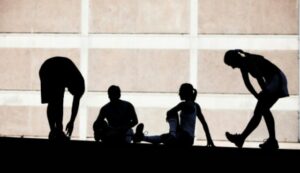Why is it important to stretch?
Every sport that we carry out, whether it is daily training or sporadically, is based on the functioning of the musculoskeletal apparatus, specifically in the muscular system, therefore, if the mechanical functioning, and the state of muscle length, do not is the right one, it will have negative consequences when it comes to rendering.
It is important that the joints be stretched before and after performing an exercise, in this way greater flexibility will be achieved in them.

When a muscular imbalance occurs, between the right and the left side, or between the upper and anterior part, a decrease in sports performance is generated, in addition to the fact that the muscular, articular or interosseous structures will suffer greater suffering, and they will be predisposed to suffer all kinds of injuries, tendonitis, muscle tears, overloads, etc.
Although stretching becomes quite a heavy task, it is recommended that both active people, who engage in daily exercise, or a certain sport, as well as inactive people, do it, as it will prevent different pains, or Let the muscles mount them.
How to stretch correctly?
For the stretching to take effect, a previous warm-up routine must be carried out. There are different exercises such as walking between 5 and 15 minutes, lightly, riding a bicycle, climbing stairs, or running at a slow pace. These are low intensity, and are the most suitable.
Each muscle and joint should be stretched between 5 and 20 seconds, repeating them between 2 and 5 times. It is important that the tension that is exerted be gradual, start off light, and gradually increase, it is essential that in order to know that the stretching is being done correctly, a kind of tightness is noticed in the area.
What benefits do stretching offer?
- Correct absorption of lactic acid is achieved, which is what causes stiffness.
- A good stretch avoids possible discomfort and painful cramps, which usually appear as a result of a lack of magnesium in muscle tissue. If we stretch, we will help this mineral reach the inner part of the muscle more easily.
- Blood and nutrients are increased, which reach both the muscles and the joints, in this way the impact of performing the exercises is coped with in a more optimal way.
- It prevents the muscles from being stiff, because if you stretch both before and after playing sports, a greater number of movements are produced, which have as a positive consequence, the slower degeneration of the joints.
- Fewer injuries and discomfort occur, since the muscles, being more flexible, reduce their tension, heat up and avoid possible pain.
- If we stretch the shoulders, chest and lower back correctly, we will achieve an aligned back, so we will have a good posture.
- It is a very good way to relax and free the body from the loads and stress generated during the exercises. When a muscle is stressed, the muscle fibers shorten, responding to the force exerted by the load to which they are being subjected, until the tension builds up enough that the muscle begins to return to its normal, relaxed length..
Stretching exercises
- Lateral Bend Stretch: Laterally bend your neck to the right, helping yourself with the opposite hand. You must repeat it 3 times and hold the position for 10 seconds.
- Stretching of intercostal muscles: Stand up, with your feet together, stretch your arms and put them high, above your head, with your hands intertwined, and pull upwards, as if you wanted to reach something, which is in a high place. Do the same as you lower your body, to the right side, to waist height, inhaling air, and come back up? Then do the same but to the left side, take a breath as you go down and release it as you go up.
- 3. Back stretch:
- Back Stretch: Lie face down on the floor with your palms flat on the floor, slowly arch your spine, stretching your head back and lifting your chin. You must repeat it 3 times and hold it for 15 seconds
- Lumbar stretch: Separate the legs and bend them, place one hand behind the thigh, and raise the knees towards the chest, you must accompany it with breathing. Repeat 2 times with each leg.
- Shoulder Stretch:
- Shoulder movement: Raise your shoulders up, holding that position for 5 seconds while you breathe in, then relax and exhale. Repeat it about 5 times.
- Shoulder Flexion Stretch: Face a wall while slowly walking your fingers up the wall until you feel a stretch. Hold the stretch for 30 seconds.
Back of the shoulder stretch: Stand up, reach one arm forward and with the hand of the other arm; stretch it to the opposite side. Repeat 5 times with each arm and hold for seconds.
- Arm and wrist stretch:
- Wrist extension: Extend your arm forward, and with the help of the other hand, direct the palm upwards, flexing it until it is vertical as much as you can, start with the right hand, and continues with the left.
- Ulnar flexion: Stretch your arm forward, palm down, and with the help of the opposite hand, stretch until it is in a vertical position. You must do it with both hands.
- Triceps stretch: Sit or stand, go behind your head, arm behind your back and with the hand of the other arm exert force towards the other shoulder. Do it 5 times with each arm for about 15 seconds.
- Biceps Stretch: Stand up, grab a stick, or a towel, and reach one arm behind you, keeping your elbow extended, placing it in the middle of your back, and with the other arm positioned behind your head, stretch stick or towel up. You must repeat it 6 times, with each arm and hold it for 6 seconds.
- Quadriceps stretch: Grab a bent leg with your hand, stretching it backwards, and bringing it towards the buttocks; you should feel how the quadriceps pulls you. You must repeat this exercise, 3 times with each leg.
- Leg stretch:
- Leg stretch: Sit down and spread your legs, keeping your knees straight, and your spine straight, without arching it, try to touch the tips of your toes with your hands. Each repetition should last 10 seconds.
- Calf stretch: It can be done with shoes, but it is more effective if done barefoot. Bend one leg forward, and stretch the other back, keeping it straight, forward the hip to align it with the head and spine. You must do it with each leg for 10 seconds.
- Hamstrings: Stand in front of a fence, bar or even a table, the height of the object should be similar to that of your hip, although it can be a little higher. Rest your heel on it, keeping your leg straight. The other leg is the support point and it is recommended that you keep it slightly bent, as it will cause a greater stretch. Move your body forward on the leg, always according to the flexibility you have, you can also do it with a straight back, and in this case you must flex the supporting leg more. You must stay for 15 seconds with each one.
- Hip flexors. Stand up, move one leg forward, forming a right angle, and pull the other leg back, keeping it extended. Then lower your hips, slowly, you should feel a slight stretch in your hips, groin, and hamstring. You can add the straight foot on the rear leg. You must hold for 10 seconds with each one.

















